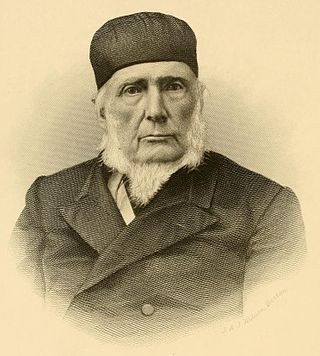
New Bedford is a city in Bristol County, Massachusetts, United States. It is located on the Acushnet River in what is known as the South Coast region. Up through the 17th century, the area was the territory of the Wampanoag Native American people. English colonists bought the land on which New Bedford would later be built from the Wampanoag in 1652, and the original colonial settlement that would later become the city was founded by English Quakers in the late 17th century. The town of New Bedford itself was officially incorporated in 1787.
Wamsutta Oil Refinery was established around 1861 in McClintocksville in Venango County near Oil City, Pennsylvania, in the United States. It was the first business enterprise of Henry Huttleston Rogers (1840–1909), who became a famous businessman, industrialist and financier.
Wamsutta, also known as Alexander Pokanoket, as he was called by New England colonists, was the eldest son of Massasoit Ousa Mequin of the Pokanoket Tribe and Wampanoag nation, and brother of Metacomet.

Plain weave is the most basic of three fundamental types of textile weaves. It is strong and hard-wearing, and is used for fashion and furnishing fabrics.

The Amoskeag Manufacturing Company was a textile manufacturer which founded Manchester, New Hampshire, United States. From modest beginnings it grew throughout the 19th century into the largest cotton textile plant in the world. At its peak, Amoskeag had 17,000 employees and around 30 buildings.
The manufacture of textiles is one of the oldest of human technologies. To make textiles, the first requirement is a source of fiber from which a yarn can be made, primarily by spinning. The yarn is processed by knitting or weaving, which turns yarn into cloth. The machine used for weaving is the loom. For decoration, the process of colouring yarn or the finished material is dyeing. For more information of the various steps, see textile manufacturing.

Pocasset Manufacturing Company was a cotton textile mill located in Fall River, Massachusetts. It was located just west of Main Street across the second falls of the Quequechan River. It was organized on August 15, 1821, with $100,000 in capital. The mill began operation in 1822, with Samuel Rodman of New Bedford as the principal owner. Oliver Chace, served as the mill's agent until 1837. Nathaniel Briggs Borden was named clerk and treasurer.

Joseph Grinnell was a U.S. Representative from Massachusetts and friend of Abraham Lincoln, and the brother of Moses Hicks Grinnell.

The Hathaway Manufacturing Company was a producer of cotton textiles founded in New Bedford, Massachusetts in 1888 by Horatio Hathaway, a China trader and whaler in the Pacific.

The Whitin Machine Works (WMW) was founded by Paul Whitin and his sons in 1831 on the banks of the Mumford River in South Northbridge, Massachusetts. The village of South Northbridge became known as Whitinsville in 1835, in honor of its founder.

The American Printing Company, located in Fall River, Massachusetts grew to become the largest producer of printed cotton cloth in the United States by the early 20th Century. The company grew as an offshoot of the Fall River Iron Works, established in 1821 by Colonel Richard Borden and Major Bradford Durfee. The American Print Works was established in 1835 by Holder Borden. It employed several thousand workers at its peak during World War I.

Sanford Spinning Company is an historic mill complex located on Globe Mills Avenue in Fall River, Massachusetts. It was added to the National Register of Historic Places in 1983, along with the adjacent Globe Yarn Mills #3.

The Cohannet Mill No. 3 is an historic textile mill located at 120 Ingell Street in Taunton, Massachusetts. The mill was built in 1890 and added to the National Register of Historic Places in 2006. It is the only remaining mill of the Cohannet Mills company, founded in 1847 for the manufacture of fine cotton yarns.
Springs Global is a Brazil-based multinational corporation engaged in the manufacturing, marketing, and sale of packaged textile and non-textile home furnishings. It makes textile goods, such as sheets, pillows, bedspreads, towels and bath rugs, under the Springmaid and Wamsutta brands. Other well-known brands from Springs Global include Regal, Beaulieu, Bali, and Nanik. It operates in Argentina, Mexico, Brazil, Canada and the U.S. and has about 30 manufacturing units in 13 states of the U.S.

The Troy Cotton & Woolen Manufactory was a textile manufacturing company located Fall River, Massachusetts. Founded in 1813 by Oliver Chace, it was the second textile mill to be built over the Quequechan River, after the Fall River Manufactory. It was located at what is now Troy Street between Pleasant and Bedford Streets.

The Fall River Manufactory was the first cotton mill to be constructed across the Quequechan River in Fall River, Massachusetts, United States. It was also the first successful textile mill in the area.
The following is a timeline of the history of New Bedford, Massachusetts, United States.
Pranker Mills, also known as the Iroquois Mills, is a former American textile mill located in Saugus, Massachusetts that was in operation from 1822 to 1915.

The 1928 New Bedford textile strike was a mass work stoppage of approximately 30,000 machinery operatives in several of the large cotton mills located in New Bedford, Massachusetts, USA. The strike, which ran for several months during the spring and summer of 1928, is remembered for the prominent role played by the Workers (Communist) Party of America in mobilizing the immigrant workers of the region.
















